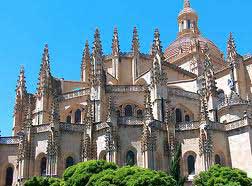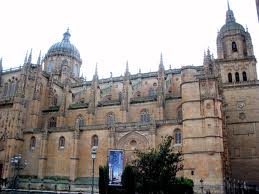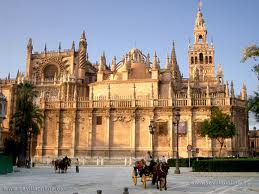Plateresque Renaissance Architecture
Symbolically, the year 1492 is considered by many to be the time when Spain walked through the threshold of the Renaissance, leaving behind the sinister obscurantism of the Middle Ages. In architectural terms, at least, the reality is that for the best part of XV century artists in the peninsula had exploited every decorative possibility available to them, and it is quite likely that the earliest version of Spanish Renaissance, the Plateresque, emerged primarily as a new ornamental alternative.

The transition from the intricate excesses of the Isabelline style to the unique forms of the Plateresque was guided, primarily, by aesthetic requirements that led to additions of what, ultimately, were Renaissance elements. So much is evident from the earliest constructions that evidence the new fashion, such as the New Cathedral of Salamanca, Segovia Cathedral or some of the elements added to the Cathedral of Seville during the early days of the VI century.
One of the pivotal figures in the development of the eclectic Plateresque style was Juan Gil de Hontañón, who had been in contact with Juan Guas, one of the most important exponents of Spanish Flamboyant architecture, in Segovia. As a matter of fact, the layout of Segovia Cathedral, built between 1525 and 1577, is attributed to Gil.
Segovia Cathedral is best described as an eclectic, monumental building. In the shape of a Latin cross, with a single, massive apse, a huge bell tower, a central cupola and a considerable cloister, it still displays eminently gothic elements, such as numerous flying buttresses on both sides of the nave and around the apse, combined with Flamboyant elements, such as pinnacles, decorative balls and crests and arrows on the walls, which contrast with the many windows, which are predominantly semicircular windows.
Salamanca
Gil would also work in the new Salamanca Cathedral of , whose master builder from 1525 to 1537 would be Juan de Álava. Another pivotal name in the early development of Plateresque, Álava imported a number of stylistic tendencies from Italy which he incorporated into the construction of the cathedral without altering the prevalent Flamboyant gothic conceptions (flying buttresses, rib-vaulted ceilings) beyond aesthetic considerations.

A central nave with two rows of aisle, each lower than the previous, the New Salamanca Cathedral often stuns visitors and students who attend spanish courses in Salamanca with its tremendous proportions. Much like Segovia Cathedral, this structure displays a dialogue between traditional gothic systems of construction, with later decorative developments, such as the replacement of gargoyles with royal crests, for instance.
However, the most typically Plateresque element of the New Salamanca Cathedral corresponds to the main facade, inscribed in a five-part semicircular and slightly detached archery, split into thee horizontal sections, crowded with several variations of ogee arches and decorated in sumptuous relief, it is the work of Rodrigo Gil de Hontañón, son to the previously mention Juan Gil de Hontañón, and principal culprit of the propagation of Plateresque in Salmanca, particularly, and in Castile, generally.
Probably the most extraordinary sample of this singular Renaissance style, though, is the facade of the Escuelas Mayores building of the University of Salamanca, which, while still split in three horizontal sections (following the gothic tradition) is crowded with the faces and crests of the Catholic Monarchs, Charles V and the Pope, and is richly decorated in stucco, making the wall appear like a metal plate hammered into shape by a smith.
Seville

Away from Salamanca, the other great center of Plateresque architecture can be found if you visit Seville, where both Gil de Hontañons worked in the extension of the cathedral. Indeed, Juan's successor as master builder at the cathedral, Diego de Riaño, would play a crucial role in the establishment of the style in the city.
Undoubtedly, Riaño's most lasting legacy — the one you have to see if you intend to visit Spain — is the City Council of Seville, formerly known as the Casa Consistorial, one of the very first buildings to assume the horizontality of Italian Renaissance ahead of the verticality of the previous gothic, incorporating decorative features such as the grotto-like detached archeries, the return of the semicircular arches and the use of heraldry and carving on the facades as ornamental elements.
Well into the XVI century, Renaissance had taken its time to carve its niche in the Spanish temperament. But now, finally, after centuries of development, it had arrived.
